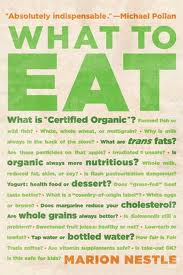What To Eat, by Marion Nestle
Jul 5
2006

Wordcandy doesn’t review much nonfiction. It’s not that we have anything against nonfiction. It's just that the nonfiction books we tend to read (and then pass along to each other, because, hey, misery loves company) are frequently depressing, and none of us want to linger over the subjects in question—global warming, voter fraud, the contents of a McDonalds hamburger—long enough to write a halfway decent review.
Happily, this wasn’t the case with Marion Nestle’s much-talked-about new book What to Eat. Ms. Nestle’s book was entertaining, informative, and totally non-depressing. Sure, it was over five hundred pages long, and we’ll never be able to fully enjoy a bowl of Cookie Crisp cereal again, but otherwise it was an 100%-Wordcandy-approved reading experience.
Nestle's book explains that U.S. food companies produce enough food to feed every American roughly 3,900 calories each day—twice the amount the average adult needs to eat. This overabundance of food forces food companies to go to outrageous, frequently misleading advertising lengths to persuade consumers to purchase their products. The organization of Nestle’s book mimics the average grocery store layout, with sections devoted to vegetables, meat and dairy products, cereals, etc. Each section analyses its subject from several different angles: taste, cost, health benefits, and social impact. Nestle also considers what one might call the “irritation factor”—i.e., how egregiously manipulative is the product’s marketing, and how much does it insult the consumer’s intelligence? For example, in an effort to suggest that the product in question offers some kind of health benefit, a cereal company might advertise their products as “a low-cholesterol food”—grains never contain cholesterol—or the label on a bottle of olive oil might proudly read “Zero carbs!”. (Oil is pure fat, so of course it has no carbs.) These meaningless encomiums are there, Nestle suggests, to distract the buyer from the negative aspects of the food in question.
Some of the things that Nestle points out seem obvious. Even if Pepsi slaps a “Smart Spot” label on a bag of baked cheese curls, does anybody really think they’re a health food? (Pepsi’s “Smart Spot” requirements are hilarious. To qualify for the “Smart Spot” label, the product in question just needs to be 25% lower in sodium or cholesterol or fat than the original version.) However, Nestle did point out several iffy health claims that we had accepted without question (the section about yogurt came as a terrible shock). One wonders how dieters will feel about Nestle: she gets pretty nasty about fad diets, stating repeatedly that the only way to lose weight is to eat less and move more. That might be tough for a reader who's lived without bread for six months to hear.
Still, What to Eat offers something to interest most readers. Everybody’s got to eat, and Nestle's book will allow us to enter the grocery store armed with a deeper understanding of the ways that the food industry tries to trick us into spending ever more money—particularly on the kind of unhealthy, cheap-to-produced foods that most of us shouldn’t be buying in the first place.
Happily, this wasn’t the case with Marion Nestle’s much-talked-about new book What to Eat. Ms. Nestle’s book was entertaining, informative, and totally non-depressing. Sure, it was over five hundred pages long, and we’ll never be able to fully enjoy a bowl of Cookie Crisp cereal again, but otherwise it was an 100%-Wordcandy-approved reading experience.
Nestle's book explains that U.S. food companies produce enough food to feed every American roughly 3,900 calories each day—twice the amount the average adult needs to eat. This overabundance of food forces food companies to go to outrageous, frequently misleading advertising lengths to persuade consumers to purchase their products. The organization of Nestle’s book mimics the average grocery store layout, with sections devoted to vegetables, meat and dairy products, cereals, etc. Each section analyses its subject from several different angles: taste, cost, health benefits, and social impact. Nestle also considers what one might call the “irritation factor”—i.e., how egregiously manipulative is the product’s marketing, and how much does it insult the consumer’s intelligence? For example, in an effort to suggest that the product in question offers some kind of health benefit, a cereal company might advertise their products as “a low-cholesterol food”—grains never contain cholesterol—or the label on a bottle of olive oil might proudly read “Zero carbs!”. (Oil is pure fat, so of course it has no carbs.) These meaningless encomiums are there, Nestle suggests, to distract the buyer from the negative aspects of the food in question.
Some of the things that Nestle points out seem obvious. Even if Pepsi slaps a “Smart Spot” label on a bag of baked cheese curls, does anybody really think they’re a health food? (Pepsi’s “Smart Spot” requirements are hilarious. To qualify for the “Smart Spot” label, the product in question just needs to be 25% lower in sodium or cholesterol or fat than the original version.) However, Nestle did point out several iffy health claims that we had accepted without question (the section about yogurt came as a terrible shock). One wonders how dieters will feel about Nestle: she gets pretty nasty about fad diets, stating repeatedly that the only way to lose weight is to eat less and move more. That might be tough for a reader who's lived without bread for six months to hear.
Still, What to Eat offers something to interest most readers. Everybody’s got to eat, and Nestle's book will allow us to enter the grocery store armed with a deeper understanding of the ways that the food industry tries to trick us into spending ever more money—particularly on the kind of unhealthy, cheap-to-produced foods that most of us shouldn’t be buying in the first place.
Posted by: Julia, Last edit by: Julianka
No new comments are allowed on this post.
Comments
No comments yet. Be the first!